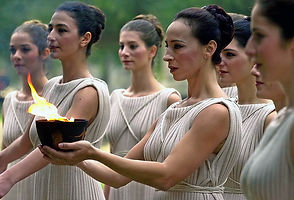
Call Us USA/CANADA (011 30) EUROPE(00 30) AUSTRALIA (0011 30)Mobile: 697 305 7711
GREECE PRIVATE TRAVEL TOURS & TRANSFERS
OLYMPIA IS AN OPEN MUSEUM
We visit Ancient Olympia as travelers, not as tourists
OLYMPIA ANCIENT CAPITAL OF PEACE AND SPORT...In the west of the Peloponnese, 16 km inland from the Ionian Sea, the main road out of Pyrgos leads into legendary Olympia’s. In a peaceful and luxuriant valley at the confluence of the rivers Alpheus and Cladeus, the vast archaeological site of Olympia stretches over the lower slopes of a hill covered with pines and olive trees that fill the air with fragrance on hot summer days.
Geography - Demography. The modern village of Ancient Olympia lies on a hill, near the remains of the magnificent and glorious structures of Olympia. Population: 1,812 inhabitants. Here is also the Museum of the Modern Olympic Games, with many choice items from the Modern Olympic Games on display (torches, stamps, and so on).
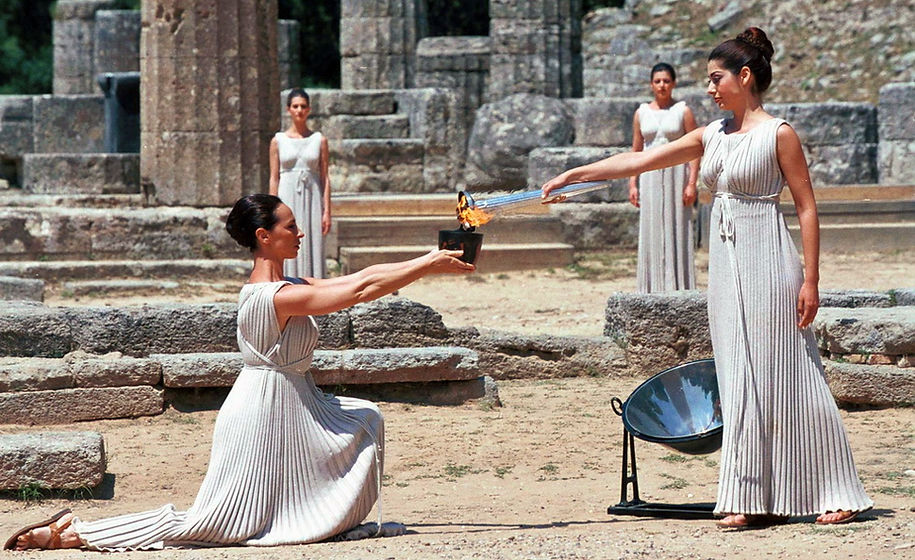
History and Mythology. The first Olympic Games were held in 776 BC, after the ‘descent of the Dorians’ to southern Greece and after the worship of Zeus had started to spread. It was a king of Elis, Iphitos, who established that the Games were to be held every four years. Athletes came to Olympia from towns on the Greek mainland - and later on from Ionia and Sicily too – to compete at Olympia for four days. At first there were only half a dozen sports, but in the fifth century BC they increased to thirteen. The prize was a kotinos, or wreath of intertwined olive branches, and it was a prize that any athlete or city longed to win. The heyday of the Olympic Games was from the sixth to the fourth century BC. The institution of the ‘sacred truce’ meant that city-states temporarily ceased hostilities, which helped them settle their disputes and realize the unity of the Hellenic nation. It was a major religious, cultural and sporting centre, a pole of attraction for Hellenism, and the bond that linked motherland Greece with the colonies of the Mediterranean and the Black Sea. The celebrations at Games-time lent the city religious splendor and influence until the 4th century BC. The sanctuary of Olympia was pillaged by the Romans in 74 BC in the course of their conquest of Greece. The Games lost their glory and the main purpose under Hadrian. Thereafter, Olympia played neither a religious nor a political role and the crowds filled the stadium from curiosity, not from faith or respect. The Games went on until 393 AD, a year before Theodosios II ‘the Great’ prohibited “pagan” festivals.
In 426 AD, Theodosios ordered the destruction of all pagan temples. In the following years, an earthquake, fire and pillage completed his work. The first excavations - by the French scientific mission of Blouet and Dubois in May 1829 revealed the exact position of the temple of Zeus. In 1875, the Greek Parliament ratified an agreement with the German Archaeological Institute, authorizing them to undertake the excavations, which are still under way.
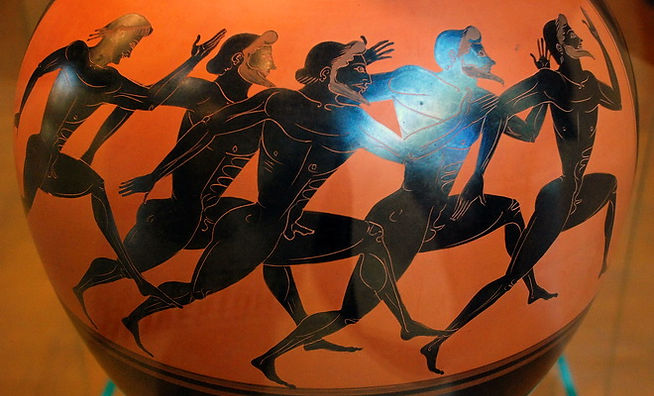
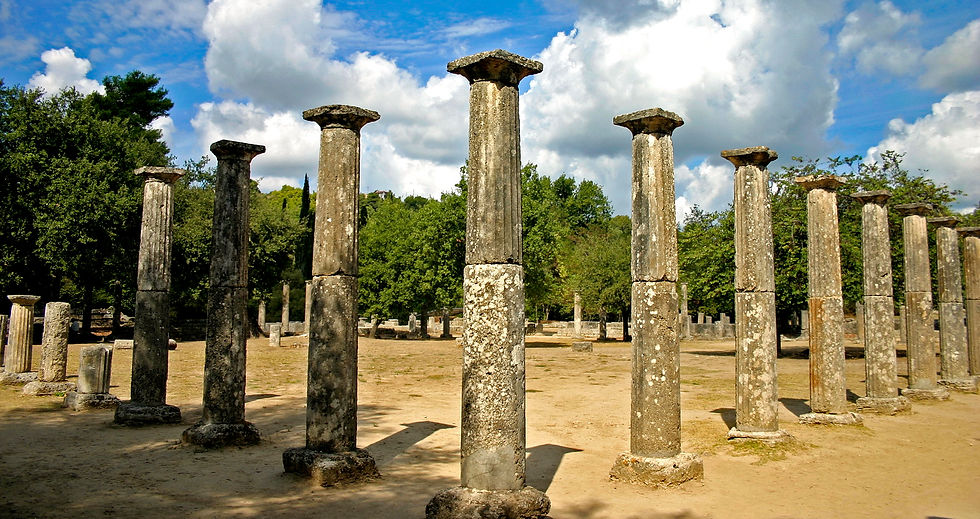


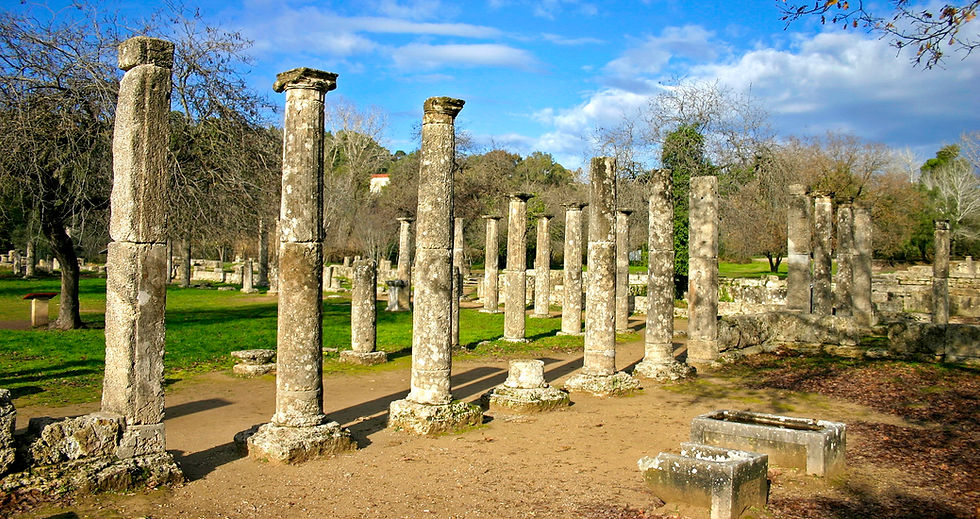
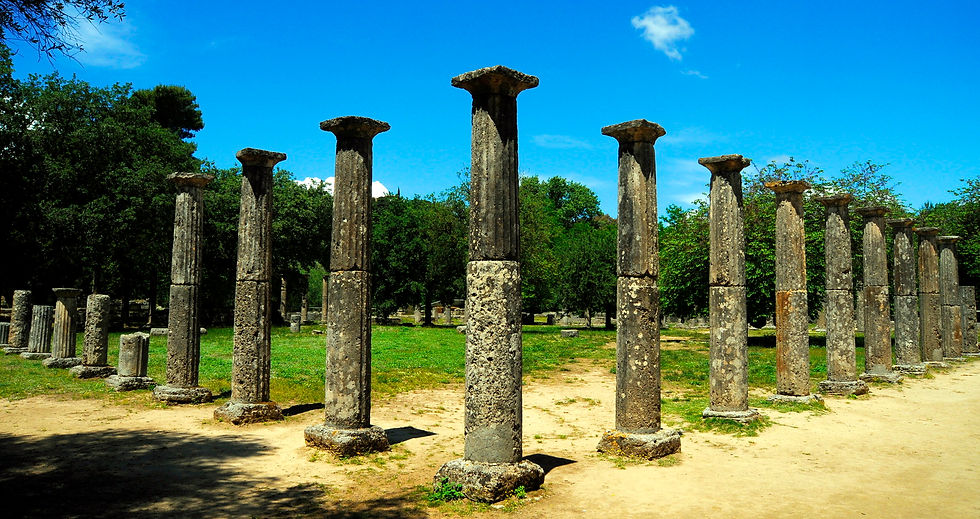
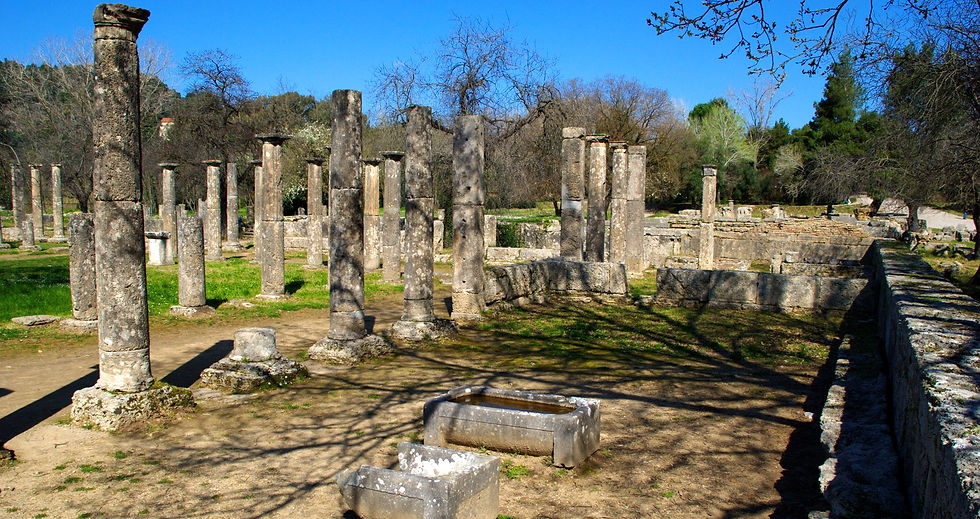
Gymnasium and Palaestra (Wrestling House).
The gymnasium in ancient Greece functioned as a training facility for competitors in public games. It was also a place for socializing and engaging in intellectual pursuits. The name comes from the Greek term gymnos meaning naked. Athletes competed in the nude, a practice said to encourage aesthetic appreciation of the male body and a tribute to the Gods.
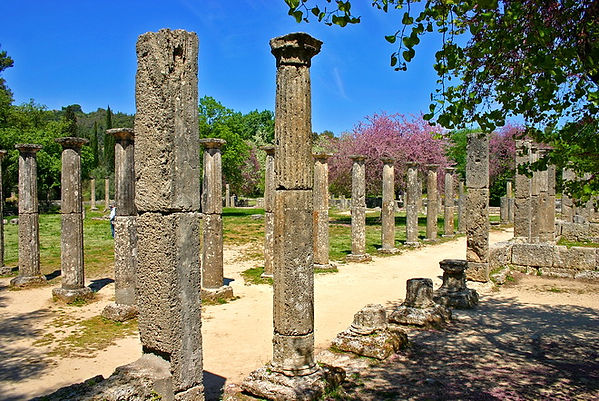
Gymnasia were typically large structures containing spaces for each type of exercise as well as a stadium, palaistra, baths, outer porticos for practice in bad weather, and covered porticos where philosophers and other "men of letters" gave public lectures and held disputations. The palaestra was the ancient Greek wrestling school. The events that did not require a lot of space, such as boxing and wrestling, were practiced there. The palaestra functioned both independently and as a part of public gymnasia. A palaestra could exist without a gymnasium, but no gymnasium could exist without a palaestra. The palaestra at Olympia is centered around a large courtyard covered with sand for use as a boxing or wrestling surface. Along all four sides of the palaestra are rooms that opened onto the porticoes. It is not possible to say for what most of the other rooms lining the porticoes were used. Since Olympia had no resident population, the palaestra and gymnasium would not have included spaces for lectures or intellectual discourse and would have been used primarily by competitors in the sanctuary games


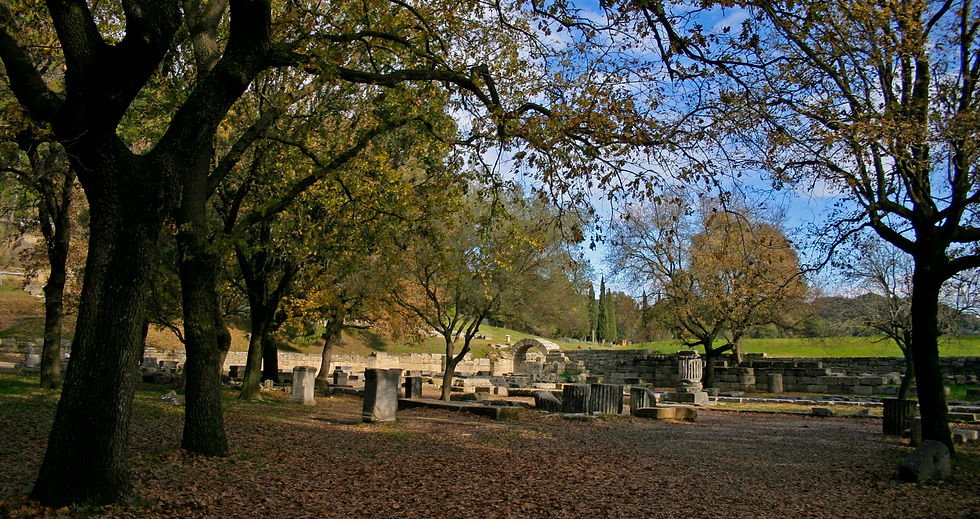
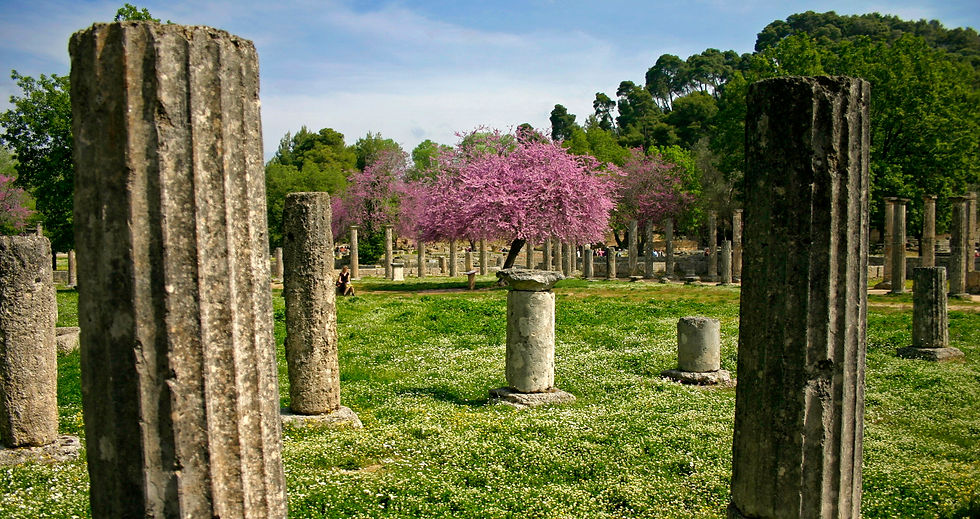
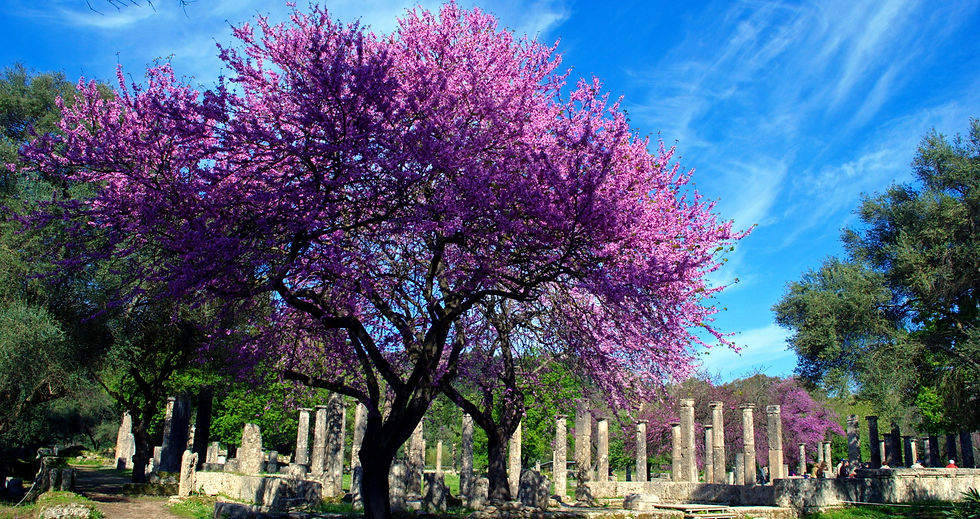

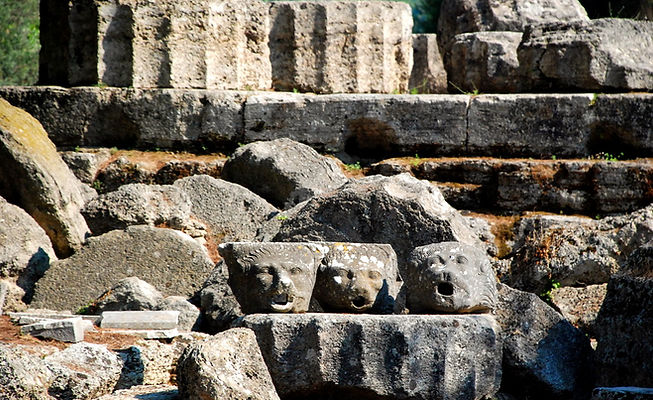
Ergastirio Fidia:The excavations of 1955-58 revealed the rectangular plan of the studio which was specially built for the sculptor Phidias to work on his statue of Zeus. Later a Byzantine church was constructed in the ruins of Phidias' studio. Leonidaion: The ground plan of this huge hostelry is reasonably clear. It was built in the 4c BC by a certain Leonidas from Naxos. It consists of four ranges of rooms set around an atrium with a circular pool in the centre added by the Romans.

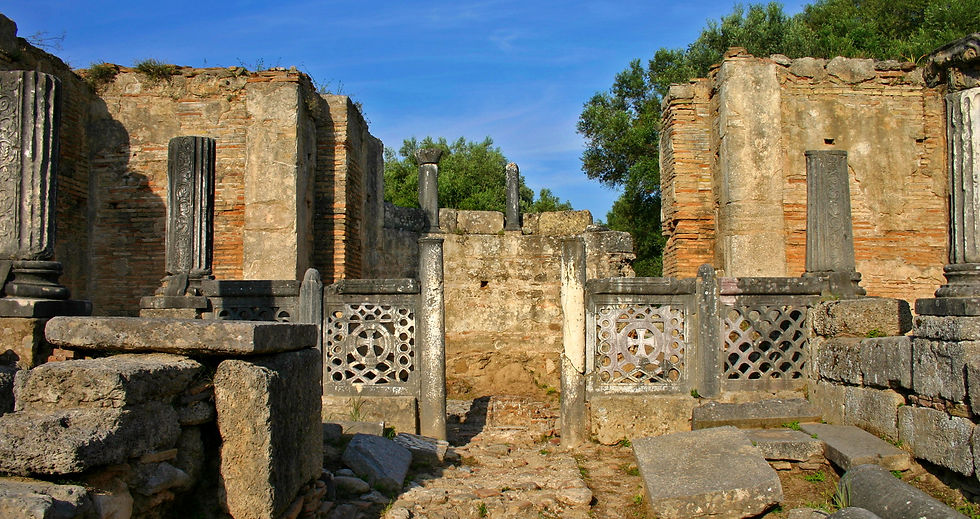

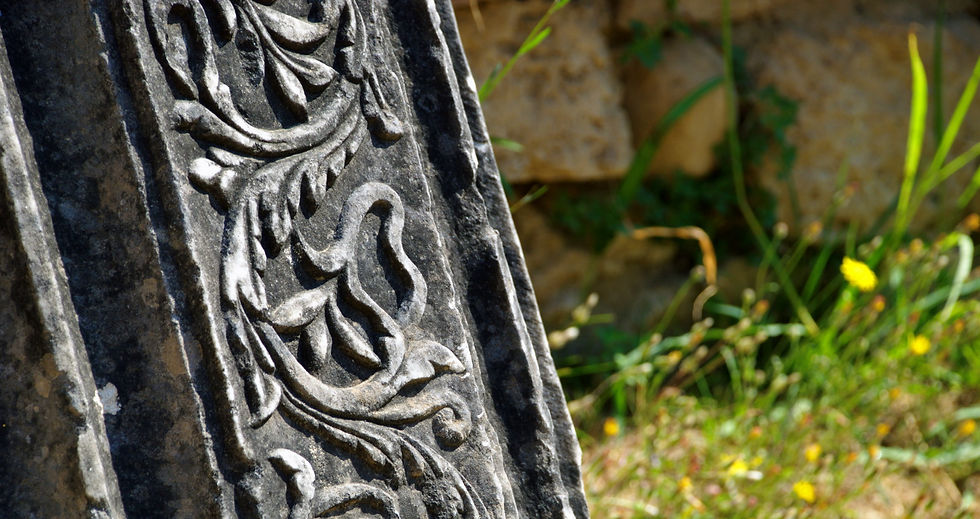
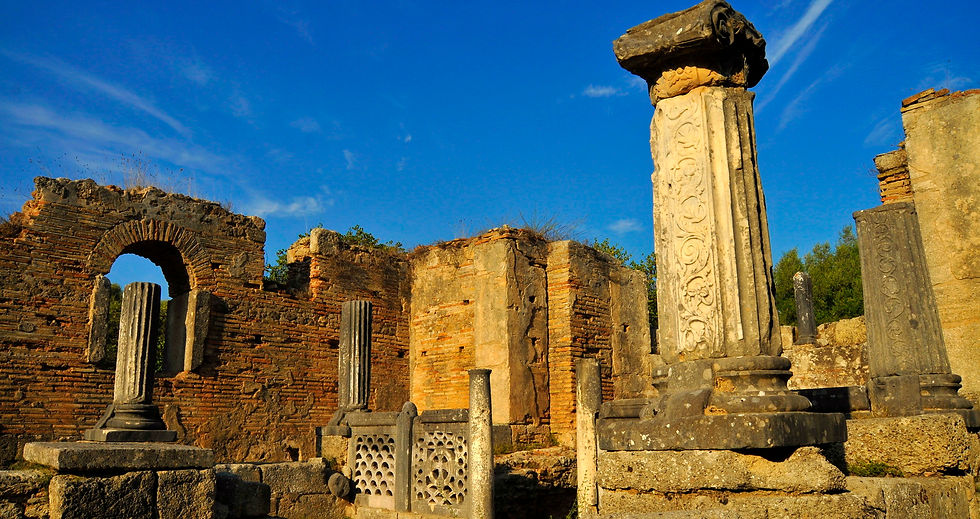
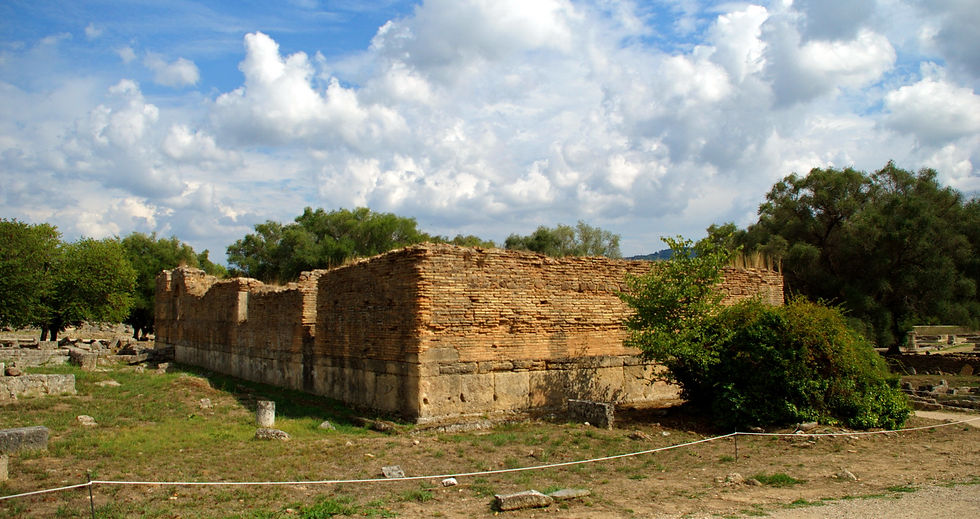
Naos Dios: Construction of the temple began around 470 BC and was probably completed by 457 BC. The architect was Libon of Elis, who worked in the Doric style. A ramp leads up to the terrace supporting the great temple of Zeus which was built in the 5c BC of local shell- limestone, covered with a layer of stucco. The entablature and study columns have collapsed and their drums and capitals lie in pieces at the foot of the high steps of the stylobate (photo). According to Pausanias, the temple's height up to the pediment was 68 feet (20.7 m), its breadth was 95 feet (29.0 m), and its length 230 feet (70.1 m). It was approached by a ramp on the east side. The temple housed the renowned statue of Zeus, which was one of the Seven Wonders of the Ancient World. The Chryselephantine (gold and ivory) statue was approximately 13 m (43 ft) high, and was made by the sculptor Phidias in his workshop on the site at Olympia. The statue's completion took approximately 12 years and was one of Classical Greece's most revered artistic works.
The Roman general Mummius dedicated twenty-one gilded shields after he sacked Corinth in 146 BC; they were fixed at the metopes of the eastern front side and the eastern half of the south side. In AD 426, Theodosius II ordered the destruction of the sanctuary. Earthquakes in 522 and 551 devastated the ruins and left the Temple of Zeus partially buried. The site of the ancient sanctuary, long forgotten under landslips and flood siltation, was identified in 1766. In 1829 a French team partially excavated the Temple of Zeus, taking several fragments of the pediments to the Musée du Louvre. Systematic excavation began in 1875, under the direction of the German Archaeological Institute, and has continued, with some interruptions, to the present time.
The chaotic heap of stones, the enormous drums and capitals of the columns thrown down by an earthquake in the 6c AD create a dramatic effect.



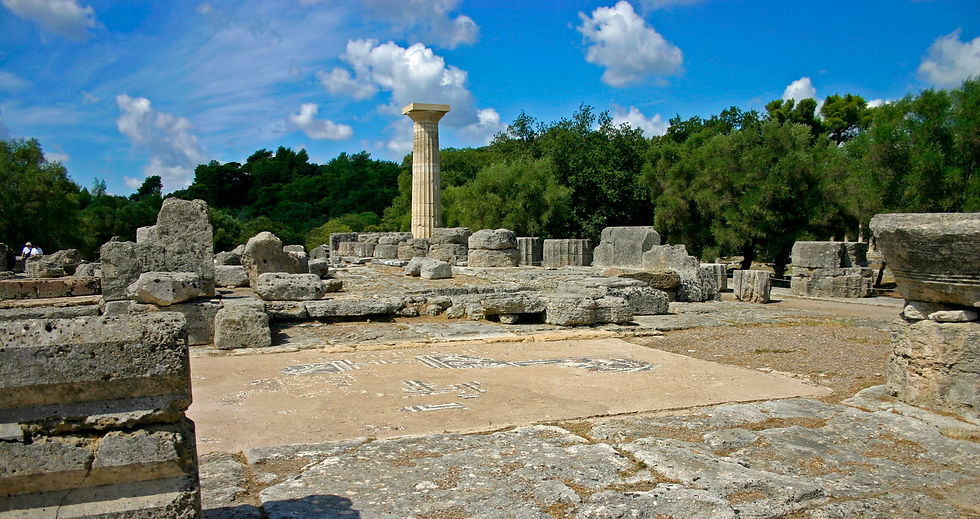
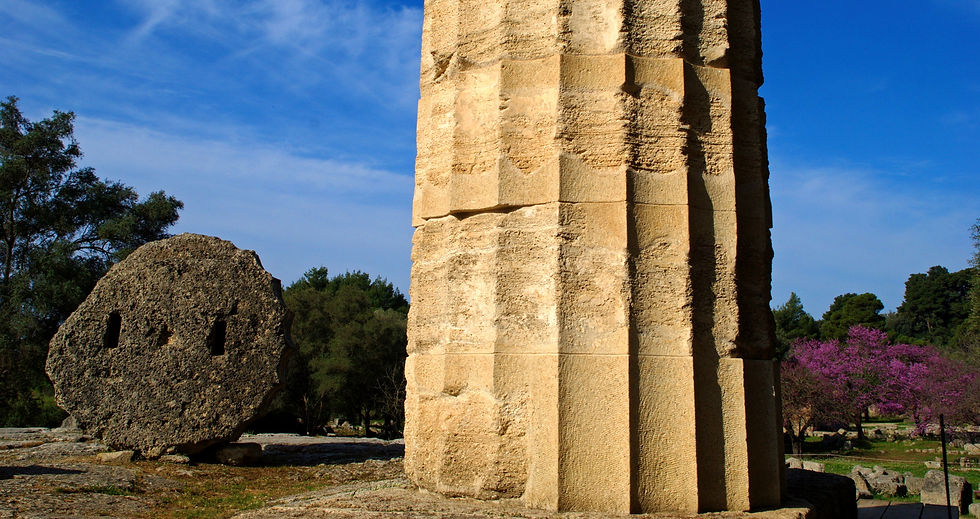


The pediments were decorated with sculptures (museum) illustrating the chariot race between Oinomaos and Pelops as well as the battle of the Lapinths and Centaurs, the friezes at the entrance to the pronaos and the opisthodromos were composed of 12 sculpted metopes (museum) of the Twelve Labors of Heracles. The naos, which consisted of a nave and two aisles, contained the famous statue of Olympian Zeus, one of the "Seven Wonders of the World".
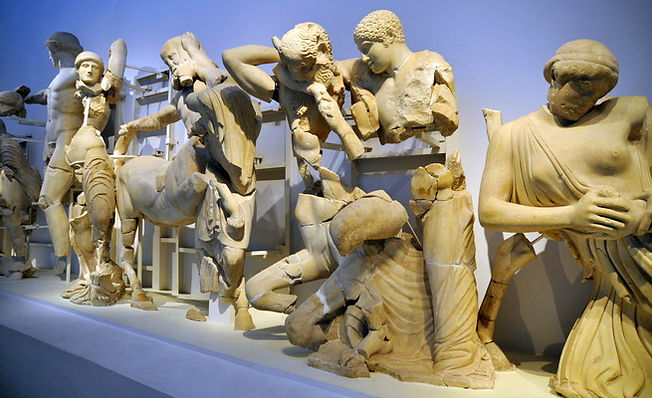
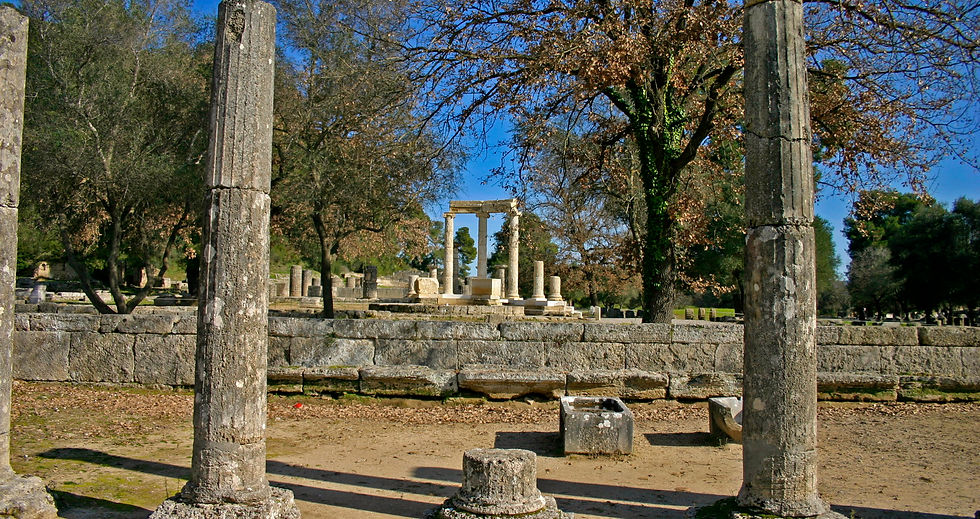



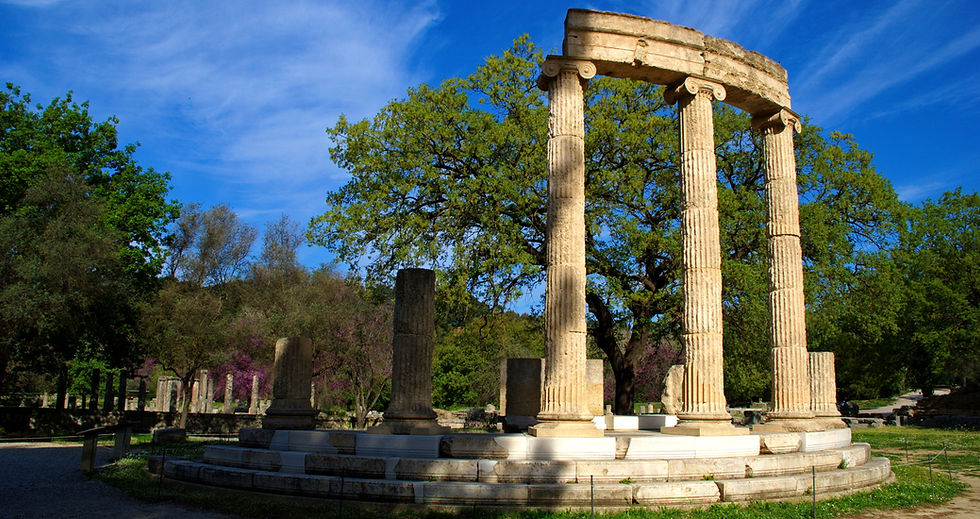
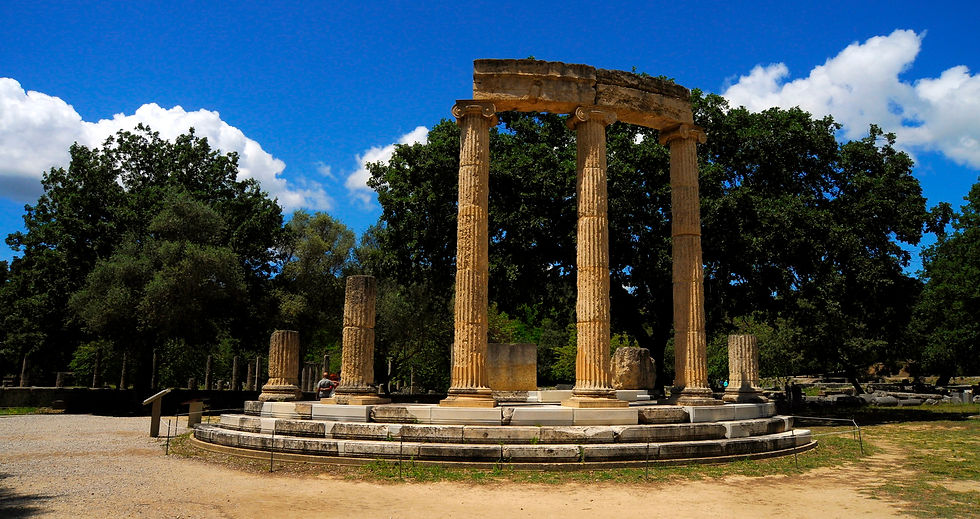
Philippeion: this circular votive monument was built in the 4c BC in the Ionic order. It was begun by Phillip of Macedon and completed by Alexander the Great. Prytaneion: Administrative centre of the sanctuary (5c BC), the perpetual flame was kept in a sacred hearth.
Stadium: In the 3c BC a passage was built beneath the terraces to link the sanctuary to the stadium. The Crypt, a vaulted passageway linking the Stadium with the Altis, was built at the end of the 3rd c. BC ( see photo) The starting and finishing lines are still visible, the distance between them was a stadium (about 194yd). The finishing line (nearest the passage) was marked by a cippus, a small low column acting as a goal or a marker round which the runners ran if the race consisted of more than one length of the stadium, the starting line was marked by several cippi. The spectators, men only, were ranged on removable wooden stands mounted on the bank surrounding the stadium. It was enlarged several times until it could accommodate 20000 people. In the middle of the south side there was a paved marble enclosure where the judges sat.
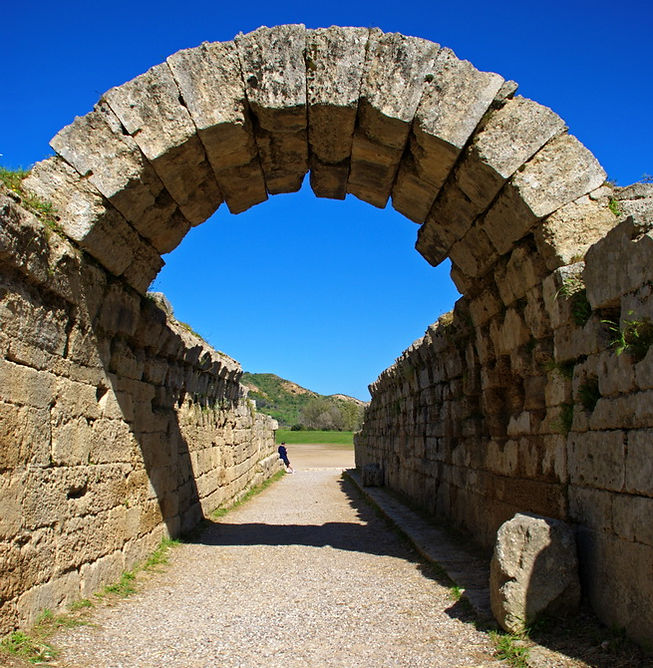

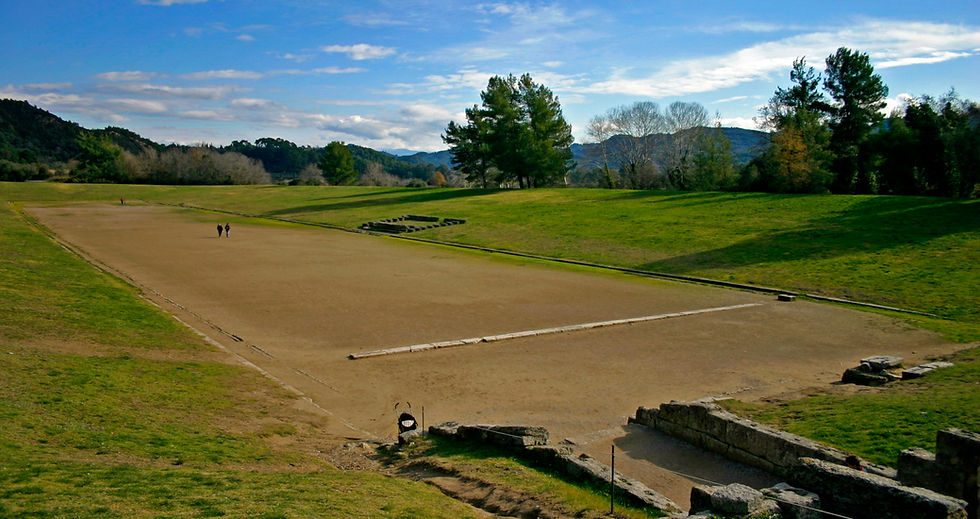
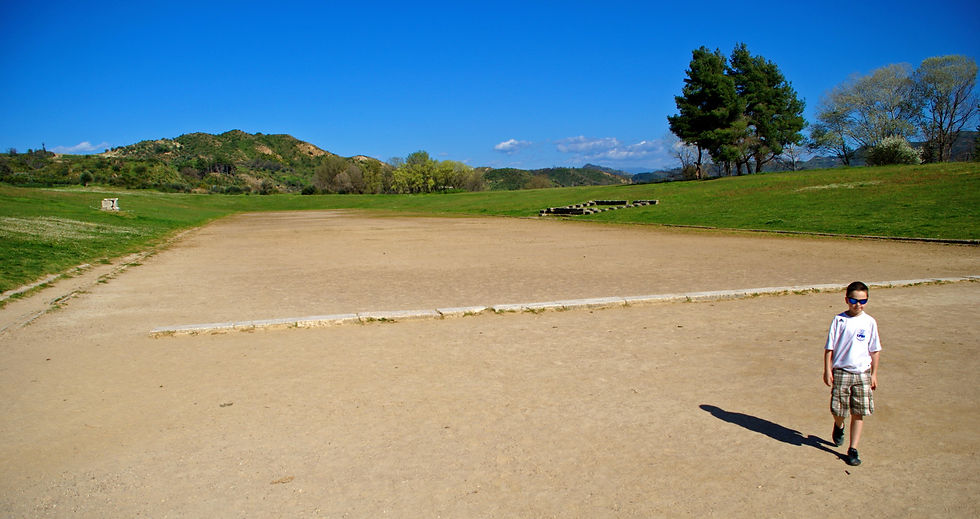
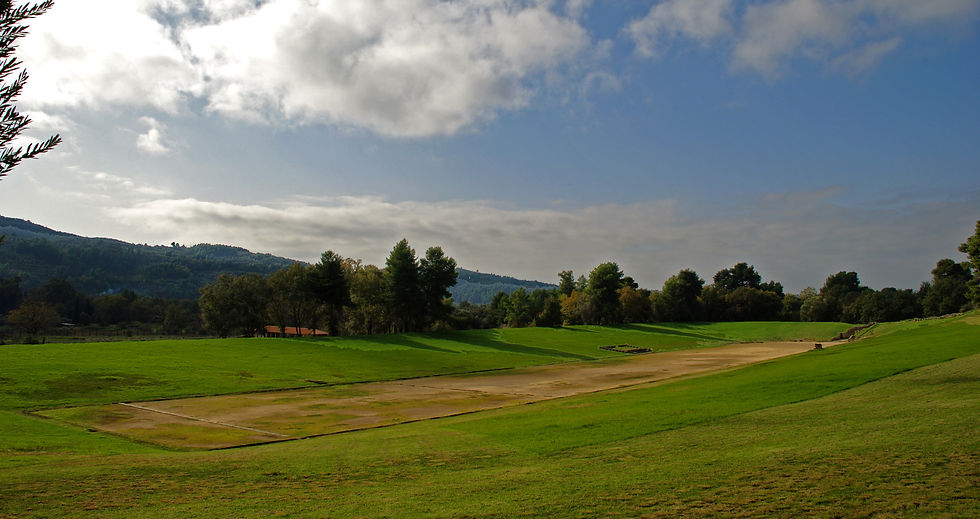



History: The first Olympic Games were held in 776 BC, after the ‘descent of the Dorians’ to southern Greece and after the worship of Zeus had started to spread. It was a king of Elis, Iphitos, who established that the Games were to be held every four years. Athletes came to Olympia from towns on the Greek mainland - and later on from Ionia and Sicily too – to compete at Olympia for five days. At first there were only half a dozen sports, but in the fifth century BC they increased to thirteen. The prize was a kotinos, or wreath of intertwined olive branches, and it was a prize that any athlete or city longed to win. The heyday of the Olympic Games was from the sixth to the fourth century BC. The institution of the ‘sacred truce’ meant that city-states temporarily ceased hostilities, which helped them settle their disputes and realize the unity of the Hellenic nation. It was a major religious, cultural and sporting center, a pole of attraction for Hellenism, and the bond that linked motherland Greece with the colonies of the Mediterranean and the Black Sea. The celebrations at Games-time lent the city religious splendor and influence until the 4th century BC. The sanctuary of Olympia was pillaged by the Romans in 74 BC in the course of their conquest of Greece. The Games lost their glory and the main purpose under Hadrian. Thereafter, Olympia played neither a religious nor a political role and the crowds filled the stadium from curiosity, not from faith or respect. The Games went on until 393 AD, a year before Theodosios II ‘the Great’ prohibited “pagan” festivals. In 426 AD, Theodosios ordered the destruction of all pagan temples. In the following years, an earthquake, fire and pillage completed his work. The first excavations - by the French scientific mission of Blouet and Dubois in May 1829 revealed the exact position of the temple of Zeus. In 1875, the Greek Parliament ratified an agreement with the German Archaeological Institute, authorizing them to undertake the excavations, which are still under way.
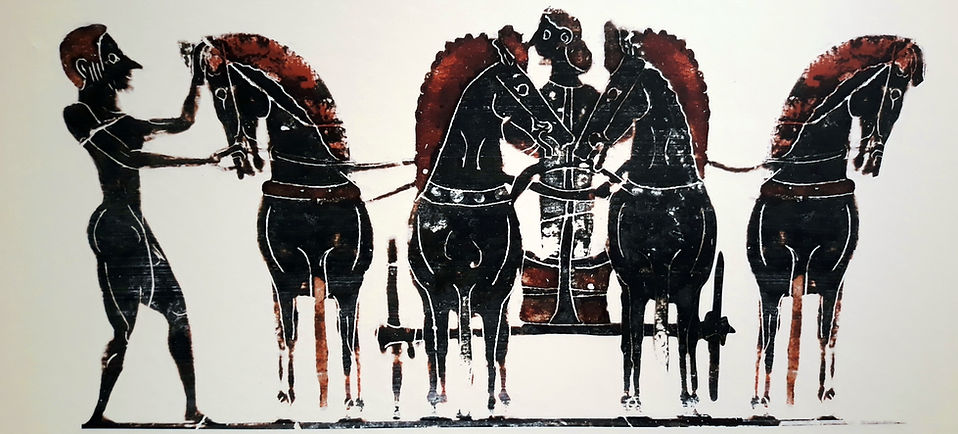
The Archaeological Museum of Olympia, one of the most important museums in Greece,
Perhaps the most famous of all the statues in the Olympia Museum is The Hermes of Praxiteles. Circa 340 BCE
Hermes is holding the infant Dionysus in his left arm, while he dangles a bunch of grapes in his right (missing) one. It is a typical pose that was reproduced almost identically in many ancient statues, but the original one was attributed to Praxiteles.
The Museum presents the long history of the most celebrated sanctuary of antiquity, the sanctuary of Zeus, father of both gods, women and men, where the Olympic games were born.
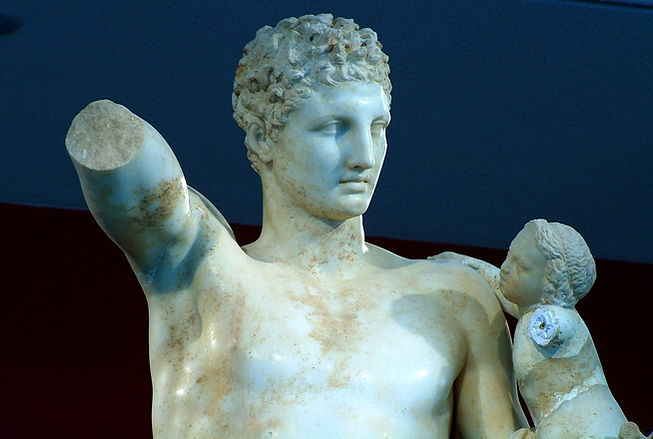
The museum's permanent exhibition contains finds from the excavations in the sacred precinct of the Altis dating from prehistoric times to the Early Christian period. Among the many precious exhibits the sculpture collection, for which the museum is most famous, the bronze collection, the richest collection of its type in the world, and the large terracotta's collection, are especially noteworthy.






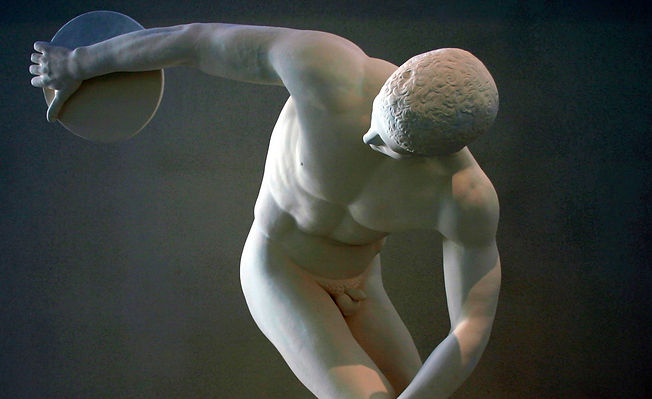
Olympic Torch
The first torchbearer on that maiden Relay was the Greek Konstantinos Kondylis, with Germany’s Fritz Schilgen the 3,075th and last. On its journey between Olympia and Berlin, the torch made its way through Bulgaria, Yugoslavia, Hungary, Austria and Czechoslovakia, finally reaching the Olympic Stadium on 1 August 1936. In the years that followed, the story of the Olympic flame began to unfold like an epic novel, with each Olympiad producing its own unique tales, played out by a cast of hundreds of thousands of runners over distances both great and small and on every possible form of transport.
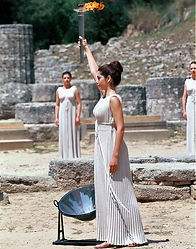
Olympic Flame
It was not until Berlin 1936, however, that the Olympic torch relay – the brainchild of the university lecturer and sports theorist Carl Diem – was first staged. As continues to be the custom today, the flame was lit in Olympia, Greece, in the same way as it was in ancient times, with the aid of a parabolic mirror reflecting the sun’s rays. Attending the lighting ceremony was Pierre de Coubertin, the founder of the modern Games, who wished the runners taking part in the inaugural relay every success.
